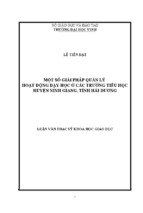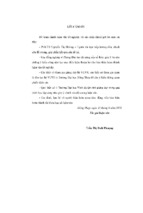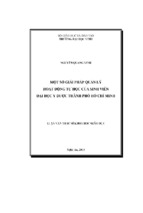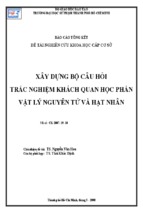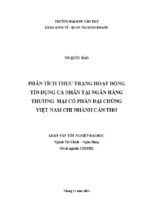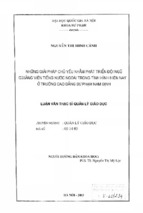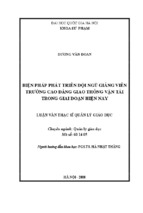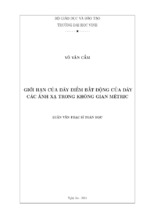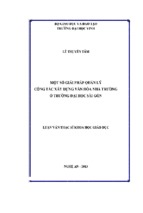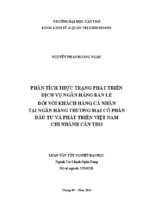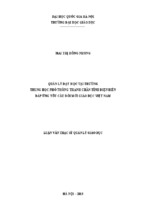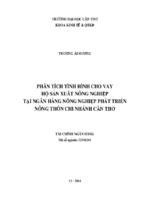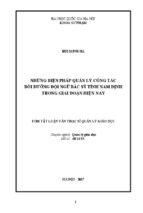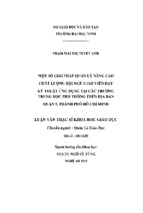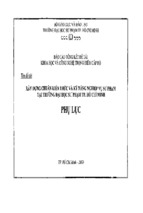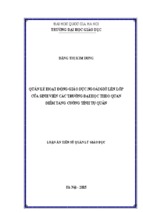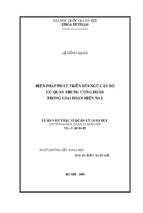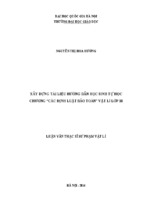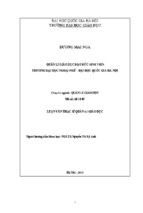VIETNAM NATIONAL UNIVERSITY, HANOI
UNIVERSITY OF LANGUAGES AND INTERNATIONAL STUDIES
FACULTY OF POST – GRADUATE STUDIES
*********************
HỒ THỊ HƯỜNG
AN EXPLORATORY STUDY ON COMMUNICATIVE NEEDS AT
TRANS-NATIONAL CORPORATIONS
(Nghiên cứu tìm hiểu về những nhu cầu giao tiếp tại những công ty xuyên quốc gia)
M.A MINOR THESIS (Type I)
Field: English Teaching Methodology
Code: 8140231.01
Hanoi - 2018
VIETNAM NATIONAL UNIVERSITY, HANOI
UNIVERSITY OF LANGUAGES AND INTERNATIONAL STUDIES
FACULTY OF POST – GRADUATE STUDIES
*********************
HỒ THỊ HƯỜNG
AN EXPLORATORY STUDY ON COMMUNICATIVE NEEDS AT
TRANS-NATIONAL CORPORATIONS
(Nghiên cứu tìm hiểu về những nhu cầu giao tiếp tại những công ty xuyên quốc gia)
M.A MINOR THESIS (Type I)
Field
: English Teaching Methodology
Code
: 8140231.01
Supervisor: Assoc. Prof. Dr. Le Van Canh
Hanoi - 2018
DECLARATION
I hereby declare that this thesis is my own work and effort and that it has not been
submitted to any other university or institution wholly or partially.
Hanoi, December 2018
Hồ Thị Hường
ACKNOWLEDGEMENTS
First and foremost, I would like to express my deep gratitude to my supervisor Assoc.
Prof. Dr. Le Van Canh who gave me a lot of valuable guidance, encouragements,
criticisms and correction throughout my thesis writing.
I am indebted to 100 technical staffs of 2 trans-national corporations - my old
students at HaUI, who provided me with lots of useful information by answering
my questionnaires.
My sincere thanks go to my family, my friends for their encouragement and support
that help me to complete my work.
ABSTRACT
This thesis reports the result of an exploratory study on the English communicative
needs by graduates from mechanical engineering and electronic department at
HaUI, who are working as technical workers at 2 trans-national corporations. It
attempts to find their common communicative needs at workplaces in order to
inform curriculum design. Simultaneously, it explores the challenges in using those
common communicative needs during their working tasks and also gives suggestions
for an effective ESP syllabus design. The data was collected by means of questionnaires
by handing them out to 100 technical workers at 2 trans-national companies. The
results of this study have shown that their common communicative needs and their
difficulties in using English at workplaces as well as given positive contributions to
ESP syllabus design.
TABLE OF CONTENTS
Page
Declaration
Acknowledgements
Abstract
Table of contents
List of abbreviations
List of tables and figures
PART I: INTRODUCTION...................................................................................1
1. Rationale for the thesis..........................................................................................1
2. Aims of the study..................................................................................................2
3. Methods of the study.............................................................................................2
4. Significance of the study.......................................................................................2
5. Scope of the study.................................................................................................2
PART II: DEVELOPMENT...................................................................................4
CHAPTER 1: LITERATURE REVIEW..............................................................4
1.1. Need analysis......................................................................................................4
1.1.1. Definition of need analysis..............................................................................4
1.1.2. Classification of “needs” in need analysis.......................................................5
1.1.2.1. Target needs.................................................................................................6
1.1.2.2. Learning needs.............................................................................................8
1.1.3. Definition of “analysis” in needs analysis.....................................................10
1.1.4. The importance of needs analysis..................................................................12
1.2. Definition of ESP and different types of ESPs.................................................13
1.2.1. Definition of ESP..........................................................................................13
1.2.2. Types of ESP.................................................................................................14
1.2.3. Characteristics of ESP...................................................................................15
1.3. Syllabus Design................................................................................................16
1.3.1. Definition of the syllabus..............................................................................16
1.3.2. Steps to design a syllabus..............................................................................17
1.4. A brief summary of some existing relevant studies..........................................17
CHAPTER 2: METHODOLOGY.......................................................................20
2.1. The research question.......................................................................................20
2.2. The participants................................................................................................20
2.3. The instruments................................................................................................21
2.4. The procedures.................................................................................................22
2.5. Methods of data analysis..................................................................................23
2.5.1. Quantitative method......................................................................................23
2.5.2. Qualitative method........................................................................................23
CHAPTER 3: FINDINGS AND DISCUSSIONS................................................24
3.1. The findings for the first research question......................................................24
3.1.1. Technical workers’ general common communicative needs..........................24
3.1.2. Technical workers’ communicative needs in terms of correspondence.........25
3.1.3. Technical workers’ communicative needs in terms of writing a document.. .26
3.1.4. Technical workers’ communicative needs in terms of order/customer
satisfaction............................................................................................................... 27
3.1.5. Technical workers’ communicative needs in terms of business meeting.......28
3.1.6. Technical workers’ communicative needs in terms of business trip..............29
3.2. The findings for the second research question..................................................30
3.2.1. Their challenges in writing email, fax, report and plan..................................30
3.2.2. Their challenges in reading email, fax, report and plan.................................31
3.2.3. Their challenges in listening and speaking for business trip and social
meeting.................................................................................................................... 31
3.3. Discussion findings..........................................................................................32
3.3.1. Technical workers’ general common communicative needs..........................32
3.3.2. Technical workers’ common challenges in using means of communication at
workplace................................................................................................................33
3.3.2.1. Recommendation for students....................................................................34
3.3.2.2. Recommendation for teachers....................................................................34
3.2.2.3. Recommendation for course and syllabus designers...................................35
PART III: CONCLUSION...................................................................................36
1. Conclusion of the study.......................................................................................36
2. Limitations..........................................................................................................37
3. Suggestions for further studies............................................................................37
References...............................................................................................................39
Appendices..................................................................................................................
LIST OF ABBREVIATIONS
HaUI:
Ha Noi University of Industry
NA:
Need analysis
ESP:
English for Specific Purposes
GE:
General English
EOP:
English for Occupational Purposes
EAP:
English for Academic Purposes
LIST OF TABLES AND FIGURES
Table 1: Brown’s different views on needs
Table 2: Brown’s different types of analysis
Table 3: Dudley-Evans & John’s classification of ESP
Figure 3.1: Technical workers’ general common communicative needs
Figure 3.2: Technical workers’ communicative needs in terms of correspondence
Figure 3.3: Technical workers’ communicative needs in terms of writing a document
Figure 3.4: Technical workers’ communicative needs in terms of order/customer
satisfaction
Figure 3.5: Technical workers’ communicative needs in terms of business meeting
Figure 3.6: Technical workers’ communicative needs in terms of business trip
Figure 3.7: Technical workers’ general common communicative needs
PART I: INTRODUCTION
1. Rationale for the thesis
With the development of economy in 21st century, there are lots of international
companies investing and opening subsidiaries in Viet Nam. They need a huge of
Vietnamese workforces to play a role as technical workers and managers of
individual departments. This is actually a good sign for Vietnamese workforce in
generally and newly graduated vocational training students of Hanoi university of
Industry (HaUI) in particular. However, in order to be employable in these transnational companies, applicants are required to possess not only solid specialized
knowledge and skills but also satisfactory communication skills in English as an
international language. That is the reason why this study was aimed at investigating
on communicative needs of industrial and business employees. Normally, graduates
from mechanical engineering and electronic department at HaUI were taught
English with popular textbooks such as new headway, objective KET or lifeline for
6 terms as a general English (GE) course and only one term with oriented ESP
course. These GE syllabuses mainly offer students with general communicative
functions such as greetings, invitation making…etc. and sets of grammar rules
before they were taught for only one semester technical English. However, during
technological and business tasks, graduates from mechanical engineering and
electronic department admitted that they had to face up with difficulties in reading
instructions, socializing with co-worker, writing formals email or reports, giving
presentations or negotiating. Therefore, it is necessary to conduct “an exploratory
study on communicative needs at trans-national corporations” for understanding
about graduates’ challenges in using English at their workplaces and for having an
effective syllabus design.
1
2. Aims of the study
The study was aimed to find out the common communicative needs at the
workplace as reported by graduates from mechanical engineering and electronic
department who are holding different positions at transnational companies. This
information will be used to informed syllabus design for the students at HaUI.
Research questions
The study was carried out to obtain information for answering the following
questions:
1. What are common communicative needs of technical workers at trans-national
corporations?
2. What are the common challenges in using English for communication at work
that they encounter?
3. Methods of the study
Given the purpose of the study, a survey method using the questionnaire to collect
data was used. One hundred graduates from mechanical engineering and electronic
departments at HaUI who are working as technical workers of individual departments
at trans- national corporations) answered the questionnaire.
The data obtained from the questionnaire was analysized quantitatively to identify the
common pattern of responses regarding the communicative needs and communicative
challenges at work that these ex-students of HaUI often encountered.
4. Significance of the study
The findings of the thesis may serve as useful information for changes in curriculum
design and teaching approaches at HaUI.
5. Scope of the study
The study only focused on the communicative functions or needs and the problems
the HaUI ex-students had in communicating in English at work as reported by these
students. Also, the participants are the ex-students from two departments (Mechanical
Engineering and Electronic) of HaUI rather than all graduates from various
departments of the university.
2
6. Structure of the thesis
Part I: Introduction presents the rationale, aims, methodology, significance and
scope of the study.
Part II: Development - consists of three chapters:
Chapter 1: Literature review – The first part provides some theoretical background
about needs analysis including definition of needs, classification of needs as well as
definition of “analysis” in NA and the importance of needs analysis. The next one is
definition of the term ESP, different types of “ESP” and characteristics of ESP.
Definition of syllabus, syllabus design and steps in designing syllabus are
mentioned to. The last one is a brief summary of some existing relevant studies.
Chapter 2: Methodology - in this chapter, the introduction of research method
including research questions, data collection instruments are presented.
Chapter 3: The study - shows the procedure of carrying on the research and
presents the data analysis result from questionnaires.
Part III: Conclusion, which is the last chapter, followed by references is the
summary of the whole study. The limitation of the study and suggestion for further
study are also recommended.
3
PART II: DEVELOPMENT
CHAPTER 1: LITERATURE REVIEW
1.1. Need analysis
1.1.1. Definition of need analysis
Needs analysis plays as the most important and crucial step in designing any
curriculums. Nunan (1988) considers that needs analysis is the very first stage of the
design of a syllabus. More importantly, it attempts to meet the needs of different
shareholders, consist of learners, language teaching institutions, and employers.
Various authors give various definitions and perspectives of that term. Needs refers
to the present or future requirement of learners, and what they expect to learn when
they finish the language course. Richterich (1972, cited in Johnson, 1982, p.40)
reflected his viewpoint on language needs: “the requirements which arises from the
use of a language in the multitude of situations which may arise in the social lives
of individuals and groups”. By doing an analysis about language needs of specific
group of learners, we may have accurate decisions for what we are going to teach
and learn.
According to Long (2005), needs analysis is kind of the diagnosis in foreign
language teaching . Richards and Rodger (1986, p.156) give a clearer definition,
according to which needs analysis is “concerned with identifying general and
specific language needs that can be addressed in developing goals, objective and
content in a language program”.
For Brown (1995, p.36) , needs analysis is “ the systematic collection and analysis
of all subjective and objective information necessary to define and validate
defensible curriculum purposes that satisfy the language learning requirements of
students within the context of particular institutions that influence the learning and
teaching situation.”
In the context of English for Specific Purposes (ESP), Evan and John (1988, p.125)
note that needs analysis in ESP encompasses the following types of information:
4
Professional information about the learners: the tasks and activities learners
are/will be using English for- target situation analysis and objective needs.
Personal information about the learners: factors which may affect the way they
learn such as previous learning experience, cultural information, reasons for
attending the course and expectations of it, attitude to English – wants, means,
subjective needs.
English language information about the learners: what their current skills and
language use are- present situation analysis- which allow us to assess (D)
The learners’ lacks: the gap between “C” and (A) – lacks
Language learning information: effective ways of learning the skills and language
in (D) – learning needs.
Professional communication information about (A): knowledge of how language
and skills are used in the target situation – linguistic analysis, discourse analysis,
genre analysis.
What is wanted from the course.
Information about the environment in which the course will be run – mean
analysis.
This definition is adopted in this study because it fits both the purpose and the
method of the study.
1.1.2. Classification of “needs” in need analysis
It is an awareness of learner’s needs to learn English that separate the definition of
ESP from GE and also influences the choice of content in an English course. In GE
course, needs are often considered by tradition and no attempt has been made on
needs while in ESP course, needs analysis is associated with syllabus.
Needs can be understood in different ways and the word needs also means to
different people in different context as: wants, desires, necessities, lacks, gaps,
expectations, motivations, deficiencies, requirements, requests, prerequisities,
essentials , the next step, and x+1 ( James Dean Brown, 2016, p.13).
5
Hutchinson and Waters’(1987) two concepts of needs: “target needs” and “learning
needs”
We can see that point clearly by paying a look on the following figures
Needs
Targets needs
Necessities Lacks Wants
Learning needs
Psychological
Attitudinal/
Material
Motivational
Hutchinson and Waters (1987) categorize two types of needs
1.1.2.1. Target needs
“Target needs” refers to the learner’s “necessities”, “lacks” and “wants” for
functioning effectively in the target situation.
- Necessities
- It is “the type of need determined by the demands of the target situation, that is,
what the learner has to know in order to function effectively in the target situation”
(Hutchinson &Waters (1987: 55). For instance, a worker needs to understand
manual instructions, diagrams or to communicate with other people who have the
same profession. He or she needs to know linguistic features such as discourse,
functional, structural, lexical which are commonly used in the situation identified.
Necessities are considered to be “what the learner has to know in order to function
effectively in the target situation” (p.55). (For example they consider whether the
learners have to write answers to exam question or not.)
- Lacks
- According to what the learner already knows, we decide what necessities are
missing. There is a gap between the existing proficiency and the target proficiency
as Hutchinson & Waters (1987:55) state: “the target needs to be matched against the
6
existing proficiency of the learners. The gap between the two can be referred to as
the learners’ lacks”. One of useful methods to know the learners’ lacks is interview
teachers and the learners should be tested before an ESP course. Lacks are assessed
whether
• Teaching and learning styles with which the learners are familiar
• Appropriate or ineffective teaching and learning methods
• Knowledge of specialized contents that teachers should have
• Suitable instructional materials and study location
• Time of study and status of English for specific purpose (ESP) courses
• Expectations about what learners should achieve in the courses.
- Wants
- In practice, different learners have different wants. Their wants consist of their
goal, their objectives and what they want to learn. “Learners may well have a clear
idea of the necessities of the target situation: they will certainly have a view as to
their lacks. But it is quite possible that the learners’ views will conflict with the
perceptions of other interested parties: course designers, sponsors and teachers”
(Hutchinson & Waters (1987:56). Robinson (1991:12) suggest of using questionnaires
to get information from a large group of learners about their wants. Wants mean
learners’ needs based on their data relating themselves and their environment. In
other words, it is exactly what the learners wish to learn.
In short, target needs is like the umbrella term, which in practice hides a number of
important distinctions. The analysis of target needs involves far more than simply
identifying the linguistics features of the target situation. As Hutchinson & Waters
(1987:59) comment: the analysis of target situation needs is in essence a matter of
asking questions about the target situation and the attitudes towards that situation of
the various participants in the learning process”. There are different ways in which
information can be gathered about needs such as questionnaires, interviews,
observations, data collection and informal consultations. The choice will depend on
7
the time and resources available. And needs analysis is not a once-for-all- activity.
It should be a continuing process.
1.1.2.2. Learning needs
“Learning needs” refer to the learner’s motivation and attitudes, interests, personal
reasons for learning, learning styles, resources and time available.
Learning needs concerns about the route between the starting point (lacks) and the
destination (necessities). For examples, learners may be greatly motivated in the
subject or work, but may completely lose interests with the long, dull, and old
teaching material. The learning process should be enjoyable, fulfilling, manageable,
and generative. It is not concerned with knowing, but with the learning. The concept
of “learning needs” put forward by Hutchinson & Waters and their analysis of
“learning needs” have been proved to be fairly useful in practice. As a result, in the
process of leaning, learner’s needs should always be taken into consideration.
Course designers need to analyze the learners’ learning needs according to their
motivation, the conditions of the learning situation, and their existing knowledge
and skills.
According to Hutchinson & Water (1987), the target needs are considered as
product-oriented needs while learning needs as process-oriented needs. The former
focuses on the requirement in learning in the target situation and is situationspecified and result-oriented, the latter links to more importance to the whole
process.
In conclusion, both target needs and learning needs must be paid attention to and
combined harmoniously in the process of designing a syllabus. As Tom Hutchinson
& Waters (1987:62) state: “the target situation analysis can determine the destination;
it can also act as a compass on the journey to give general available (i.e. the condition
of the learning situation), the existing roads within the learner’s mind (i.e. their
knowledge, skills and strategies) and the learners’ motivation for travelling”.
In my thesis, I mentioned “communicative needs” term – a definition of Richard
(1990), but I say little about it because it shares the target needs similar features.
8
Actually, communicative needs is related to the learners’ needs in the target context
and necessary specific language skills (reading, writing, speaking, listening), and
the level of language proficiency that is required by the target situation.
Some people may be confused of 2 terms between definition of Richard about
communicative needs and Hutchinson and Waters’ about target needs. According to
(Richards, 1990) & (Hutchinson and Waters’ 1987), both communicative needs and
target needs refer to learner needs in the target situation. However, the key
difference here is the former mainly focus on the language necessities of the
learners in the target context while the latter makes comparisons between the
required language abilities (necessities) of the target situation and the existing
language proficiencies of the learners (lacks), and define the gaps between the
present and target situation (wants). Brown (2016, p.13) presents needs from
various perspectives, which is summarized in Table 1 below.
Table 1. Different views on needs.
Needs views points
Democratic view
Definition of needs
What elements of the ESP
Related synonyms
Wants; desires;
majorities of all
expectations; requests;
stakeholder groups want
The difference or
motivations
discrepancy between what
Discrepancy view
They should be able to do
in the ESP and what they
Deficiencies; lacks; gaps;
requirements
currently can do
Whatever elements of the
Analytic view
ESP students should learn
next based on SLA theory
and experience
Whatever elements of the
Diagnostic view
ESP will cause harm if
they are missing
1.1.3. Definition of “analysis” in needs analysis
9
Next step; x+ 1
Necessities; essentials;
prerequisities
In the book names “Introducing needs analysis and English for specific purposes”
of James Dean Brown (2016)
There are at least eleven types of analysis strategies to ESP needs analyst to
concern.
We can understand those types clearly when looking at the following table:
Table 2. Different types of analysis.
Analysis options
Target-situation
use analyses
Target-situation
linguistic analyses
Analysis of what?
What information will the NA
What the students should
typically examine
The language uses in the particular
be able to do in the ESP at
ESP and exemplars of those language
the end of instruction
uses
The specific linguistic characteristics
What linguistic features the
students will need to know
and use in the ESP
of the ESP (vocabulary, discourse,
pragmatics) in the exemplars gathered
What the features of
above
Information about the target situation
Target-situation
learning and continuing to
in terms of the sorts of learning that
learning analyses
learn are in the ESP
students will need to do in target ESP
community
situations at various stages
What the students can do with the
Present-situation
analyses
What the students’ ESP
abilities are at the
beginning of instruction
What the disparities are
between the students’
Gap analyses
current abilities and what
the need to be able to do in
the ESP
language of the particular ESP at the
outset of instruction (with respect to
target-situations use, linguistics,
and/or learning) – using tests or other
observational techniques.
The disparities between what the
students can do at the beginning and
end of instruction with regard to the
ESP-typically based on analysis of test
scores or other observational
techniques.
10
- Xem thêm -

